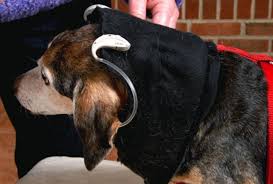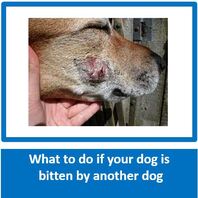|
YOUR FUR KIDS AREN’T JUST PETS, THEY’RE FAMILY.
Your cherished canines and fabulous felines are a precious part of your life. They share your ups and downs, they express emotions just like you do, and they are there for you in your best and worst times. ALWAYS. UNCONDITIONALLY. You can do the same in their time of need. We have 5 simple plans for your to choose from. www.genricpet.co.za |

What is Hearing Loss? Deafness in dogs can either be a temporary partial or total loss of hearing—due to a wax build-up in the ear canals—or permanent hearing loss due to a host of causes such as severe, untreated ear infections, congenital defects, old age and injuries. One or both ears may be affected. A veterinarian can initially examine your dog’s ear canal for wax accumulation, infections, inflammation, injury or foreign object.
Deafness refers to temporary, partial or total loss of hearing in one or both ears. Deafness may be a result of heredity, birth defects, infection, trauma, blocked ear canal or old age. Certain breeds of dogs and white or merle-coated animals are predisposed to congenital deafness. Congenital and geriatric deafness and deafness due to trauma is often permanent and not treatable. Acquired deafness (due to infection or blocked ear canal) can often be temporary and treatable.
Symptoms of Hearing Loss in Dogs Symptoms of deafness include little or no response to sound:
Types
Deafness is either congenital or acquired:
Deafness may be conductive or sensorineural:
Causes of Hearing Loss in Dogs
Causes of Congenital Deafness
Causes of Acquired Deafness
Diagnosis of Hearing Loss in Dogs
If you suspect your dog is experiencing hearing loss, you can test your dog’s hearing by clapping loudly or rattling a can of coins and noting his response. Partial hearing loss or deafness in one ear only may be can be difficult to identify. Try testing with softer sounds like snapping your fingers close to one ear or the other to look for a response.
At the veterinary clinic, the veterinarian will conduct a history and physical examination to measure hearing loss and determine any possible causes. Hearing tests may be used to diagnose hearing loss. Examination of the ear canal will detect wax accumulation, hair overgrowth, any foreign object blockage, infection, inflammation or injury and ear drum state.
If the veterinarian suspects an ear infection, ear swabs and cultures may be done to diagnose the infecting agent and determine the proper mode of treatment. In some instances, a brainstem auditory evoked response (BAER) test will be conducted to measure the brain’s response to auditory stimuli. Radiographs may be used to determine possible causes of deafness.
Treatment of Hearing Loss in Dogs
Permanent Deafness
Congenital deafness and geriatric deafness are not normally treatable. Surgery may attempt to correct hearing if the defect is in the middle or outer ear or involves inner ear inflammation, however most congenital defects involve delicate inner ear mechanics or nervous system defects. Drug toxicity, heavy metal exposure and exposure to loud noises often cause permanent damage.
Hearing Aids
Hearing aids and cochlear implants are becoming available for dogs, however they are currently still costly and somewhat impractical. The devices work similar to human devices, but animals do not respond well to the device’s presence on the body and may not tolerate it.
Foreign Body Removal
In the case of a foreign body, treatment may involve removing the blocking object, cleaning wax out of the ears, or plucking overgrown ear hair. The veterinarian will examine the ear canal for injury and normally do a thorough ear cleaning.
Treatment for Infection
The veterinarian may prescribe an ear flush and topical ointment to be used daily for 2-3 weeks along with oral antibiotics depending on severity. Pain and irritation respond well to topical provided by the veterinarian and can make the pet more comfortable quickly. A longer acting wax-based medication may be inserted into the ears at the clinic if ear washing daily at home is not feasible.
Tumors of the Ear
Surgery may be performed on tumors growing in the ear to free up the ear canal for sound conduction.
Recovery of Hearing Loss in Dogs
In cases of medical or surgical treatments, weekly follow up appointments will monitor healing and recovery. Ear infections should clear within 2-3 weeks of treatment depending on severity.
Deaf animals (whether the hearing loss is permanent or temporary) require special care. It is important to monitor pets as much as possible to avoid possible injury. Deaf pets should never be let outdoors without a fence or leash. They cannot hear when you call and cannot hear approaching vehicles.
Train your pet to understand hand signals rather than using verbal commands. Instead of calling, stomp on the ground to get a hearing impaired pet’s attention. Prevent startling the pet by letting him know when you’re around with a pat on the head. Deaf pets are prone getting lost so microchipping and collars with ID tags that identify the pet as deaf and provide contact information are a good idea.
Cost of Hearing Loss in Dogs
Hearing Loss can be an expensive treatment in dogs and can range from $200.00 to $2500.00 depending on the cost of living and severity of your Dog's hearing loss.
Deafness refers to temporary, partial or total loss of hearing in one or both ears. Deafness may be a result of heredity, birth defects, infection, trauma, blocked ear canal or old age. Certain breeds of dogs and white or merle-coated animals are predisposed to congenital deafness. Congenital and geriatric deafness and deafness due to trauma is often permanent and not treatable. Acquired deafness (due to infection or blocked ear canal) can often be temporary and treatable.
Symptoms of Hearing Loss in Dogs Symptoms of deafness include little or no response to sound:
- No response to squeaking toys
- No response to clapping
- No response to snapping fingers behind the head
- No response to doorbells, loud noises
- No response when called by name
- No response when you enter the room
- No response to other dogs barking
- Difficult to wake
- Startled when woken
- Excessive barking
Types
Deafness is either congenital or acquired:
- Congenital: Animal is born deaf due to genetic inheritance or birth defects in the development of the ear or nervous system involved with hearing.
- Acquired: Animal is born with normal hearing and develops deafness through trauma, infection, blockage of the ear canal or geriatric nerve degeneration.
Deafness may be conductive or sensorineural:
- Conductive: Sounds cannot be conducted from the outside to the nerves in the inner ear.
- Sensorineural: Nerve receptors cannot transmit sound signals from the ear to the brain or brain centers responsible for hearing cannot interpret the auditory data.
Causes of Hearing Loss in Dogs
Causes of Congenital Deafness
- Birth defects of the ear or nervous system may result from genetic inheritance or abnormal anatomic development.
- Certain dog breeds and coat colors carry a high degree of inherited deafness. White head and ears and merle coats have been associated with deafness.
Causes of Acquired Deafness
- Old age (natural geriatric nerve degeneration)
- Repeated exposure to loud noises (gunfire, stereo equipment)
- Foreign object blockage (includes wax buildup, inner ear hairs, grass, other objects, fluids)
- Injury (includes trauma to the ear canal or ear drum, head trauma causing injury to brain)
- Infection (outer, middle or inner ear bacterial or yeast infection)
- Inflammation (swelling of the ear or Eustachian tube)
- Tumors (of the ear or Eustachian tube)
- Heavy metals (exposure to mercury, arsenic or lead can lead to hearing loss)
- Drug toxicity (certain drugs can lead to deafness if used incorrectly or as a side effect including furosemide, cisplatin, chlorhexidine, ethanol, aminoglycosides, erythromycin, chloramphenicol, ethanol chlorhexidine, furosemide, cisplatin)
Diagnosis of Hearing Loss in Dogs
If you suspect your dog is experiencing hearing loss, you can test your dog’s hearing by clapping loudly or rattling a can of coins and noting his response. Partial hearing loss or deafness in one ear only may be can be difficult to identify. Try testing with softer sounds like snapping your fingers close to one ear or the other to look for a response.
At the veterinary clinic, the veterinarian will conduct a history and physical examination to measure hearing loss and determine any possible causes. Hearing tests may be used to diagnose hearing loss. Examination of the ear canal will detect wax accumulation, hair overgrowth, any foreign object blockage, infection, inflammation or injury and ear drum state.
If the veterinarian suspects an ear infection, ear swabs and cultures may be done to diagnose the infecting agent and determine the proper mode of treatment. In some instances, a brainstem auditory evoked response (BAER) test will be conducted to measure the brain’s response to auditory stimuli. Radiographs may be used to determine possible causes of deafness.
Treatment of Hearing Loss in Dogs
Permanent Deafness
Congenital deafness and geriatric deafness are not normally treatable. Surgery may attempt to correct hearing if the defect is in the middle or outer ear or involves inner ear inflammation, however most congenital defects involve delicate inner ear mechanics or nervous system defects. Drug toxicity, heavy metal exposure and exposure to loud noises often cause permanent damage.
Hearing Aids
Hearing aids and cochlear implants are becoming available for dogs, however they are currently still costly and somewhat impractical. The devices work similar to human devices, but animals do not respond well to the device’s presence on the body and may not tolerate it.
Foreign Body Removal
In the case of a foreign body, treatment may involve removing the blocking object, cleaning wax out of the ears, or plucking overgrown ear hair. The veterinarian will examine the ear canal for injury and normally do a thorough ear cleaning.
Treatment for Infection
The veterinarian may prescribe an ear flush and topical ointment to be used daily for 2-3 weeks along with oral antibiotics depending on severity. Pain and irritation respond well to topical provided by the veterinarian and can make the pet more comfortable quickly. A longer acting wax-based medication may be inserted into the ears at the clinic if ear washing daily at home is not feasible.
Tumors of the Ear
Surgery may be performed on tumors growing in the ear to free up the ear canal for sound conduction.
Recovery of Hearing Loss in Dogs
In cases of medical or surgical treatments, weekly follow up appointments will monitor healing and recovery. Ear infections should clear within 2-3 weeks of treatment depending on severity.
Deaf animals (whether the hearing loss is permanent or temporary) require special care. It is important to monitor pets as much as possible to avoid possible injury. Deaf pets should never be let outdoors without a fence or leash. They cannot hear when you call and cannot hear approaching vehicles.
Train your pet to understand hand signals rather than using verbal commands. Instead of calling, stomp on the ground to get a hearing impaired pet’s attention. Prevent startling the pet by letting him know when you’re around with a pat on the head. Deaf pets are prone getting lost so microchipping and collars with ID tags that identify the pet as deaf and provide contact information are a good idea.
Cost of Hearing Loss in Dogs
Hearing Loss can be an expensive treatment in dogs and can range from $200.00 to $2500.00 depending on the cost of living and severity of your Dog's hearing loss.






